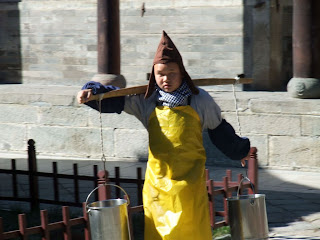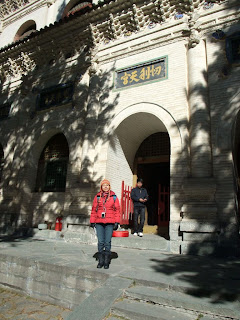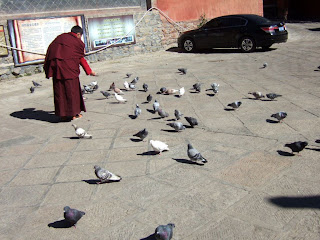
The Xiangtong-si Monastery (显通寺) is the largest temple site in Wutaishan and is one of the two oldest Buddhist Temples built in China. It was first established during Eastern Han Dynasty (25-220 AD)in year 68, few years later after the first Buddhist Temple Baima-si (白马寺) was built in Luoyang. It was said that during Han Dynasty, Emperor Hanming-Di invited two eminent monks Rev. Kasyapamatanya and Dharmavanya (摄摩腾 Motong 和 竺法兰 Chufarlan ) from India to build a Buddhist Temple (Baima-si)in its Capitol City Luoyang. The two monks in the same year went up to Wutaishan which at that time was known as Qingliang-shan (清凉山), and found that there was a Buddhist Pagoda at a mountain ridge and the place was very similar to Lingjui-feng (灵鹫峰) of India, where Buddha delivered sermons to the disciples. They thus submitted a report to the Emperor and suggested to build temples at Wutaishan. Since as mentioned in Sutra Avatamsaka, way place of Bodhisattva Manjushri was at Qingliang-shan in the east, Wutaishan thus became an ideal place for Buddhist temples. The site of Monastery Xiantong-si was constructed soon after the visit of the two monks and it was named as Dafu-lingyin-si (大孚灵鹫寺). The name was later changed to Garden Temple in Northern Wei (386-534)and The Great Avatamsaka Temple in Tang Dynasty when restoration was made during Wuzhe-Tian's period (684-704). During Ming era (1368-1644), the temple site was given with various names, such as The Great Xiantong-si (大显通寺), Jixiang-si (吉祥寺), Yongming-si (永明寺) by imperial orders of different Emperors. The name of Xiangtong-si was used by Emperor Kangxi in year 1687 during Qing Dynasty and it was continued applied until today.




The Temple site of Xiantong-si becomes main attraction to most pilgrims who came to Wutaishan not only because of its long history and size, but also due to its unique architecture and the collection of various relics treasures dating from Han (206BC -220 AD) to Qing Dynasty (1644-1911). Preserved in its Library Hall, there is a bronze cast standing Buddha statue (铜制旃檀佛) dating from Northern Wei Dynasty (386-534) and Sutra of Pagoda Leifeng-ta (雷峰塔藏经) from Northern Song Dynasty (960-1127). The Ming period (1368-1644) Boddhi leaves hand drawn 18 Arahat images and the Qing period 600,043 characters Avatamsaka Sutra Pagoda (华严经字塔) which was written with Chinese ink brush at a size as small as a mung bean by Mr. Xu-dexing (许德兴). He used 12 years to complete this piece of Buddhist Art. The two stone stele with unique Chinese character of dragon and tiger(龙虎) by two sides of the main entrance door, were from Tang Dynasty (618-907). The calligraphy followed the shapes of the two animals. Another two valuable steles were displayed in front of Manjushri Hall, one of which is blank and the other one was the true hand writing of Emperor Kangxi.



The Monastery of Xiantong-si occupies almost 120 acres of land with more than 400 building structures. The seven outstanding Halls lying from south to north, include Quanyin Hall, Manjushri Hall, Maha Vihara Main Hall, Infinity Hall, Thousand Alms Manjushri Hall, Bronze Hall and Library Hall. Each has its significant architectural features and many of them are buildings from Ming and Qing era.



The non-character Stone Stele and an old bell displayed at the compound of Manjushri Hall.



The Great Manjushri Hall enshrines 7 images of Bodhisattva Manjushri with Sweet Dew Manjushri (甘露文殊) at the back and The Greatly Wise Bodhisattva Manjushri (大智文殊) at the center of the front line. From right to left of the front lines are Clever Manjushri (聪明文殊)of East Terrace, Stainless Manjushri (无垢文殊)of North Terrace, Virgin Manjushri (孺童文殊) of Central Terrace, Wisdom Manjushri (智慧文殊) of South Terrace and Lion Roaring Manjushri (狮子吼文殊) of West Terrace.


The Guanyin Hall enshrines with Image of Bodhisattva Alvalokitesvara (观音菩萨) at the center with Bodhisattva Manjushri and Samantabhadra (文殊,菩贤菩萨) on its left and right. The Hall also known as The South Hall and Sutra Stored Hall as there are many Dharma Books displayed at its two sides. Guanyin Hall had once been the venue of the Great Water Land Assembly in the past.


The centerpiece for religious activities in the monastery is the Maha Vihara Grand Hall (大雄宝殿). The building area covers more than an acre of land, magnificent and splendid.



The Main Shrine Hall always is the venue where monks from other temples gathered, for important ceremonies or Buddhist festival held in Wutaishan.


The Grand Shrine Hall is a commodious building that houses three huge statue of Buddha Sakyamuni, Amitaba and Medicine Buddha. Behind it are images of Bodhisattva Alvalokitesvara, Manjushri and Samantabhadra and there are sculptures of 18 Arahant by the two side of walls.


Main Shrine Hall has thick roof with curving up eaves, unique and awesome.



The beautiful roofing eaves of Main Shrine Hall.


The sincere devotees bow with forehead, elbows and knees touching ground in every three steps they forward, to pay the highest respect to the Buddha at Grand Shrine Hall. This is a common practice of Mahayana Buddhists.



The fabulous color paintings and wooden carvings at the door frames and cross beams of the Main Grand Hall.





Thousand Alms Manjushri Hall.


The bronze cast Manjushri image enshrined in the Hall is most unique and treasure. It has five heads on top with 6 hands at the chest. Two of the hands are holding two golden alms bowls with an image of Sakyamuni Buddha seated in it. The other four hands stretch from the back towards all directions. Each hand also holds with a golden alms bowls seated with image of Buddha. The piece of art is known as Thousand Arms Thousand Alms Thousand Sakyamuni Manjushri Image (千臂千钵千释迦文殊像). It was made in Ming Dynasty (1368-1644) and it is rather rare in the nation.



The little wooden hexagon pillars with color painted Buddha images and mantra phrases erected at the front part of Thousand Alms Manjushri Hall are so special and gorgeous.



There was an interesting legend about the bronze giant wok of Wutaishan. Cooking 8-treasure porridge on the 8th day of 12th Lunar Month every year to offer to Buddha was the practice of every Mahayana Buddhist temples. This is in memory of the incident about the offering of congee by a shepherd girl to Buddha before he enlightened on that night. On that day the temples always boil the porridge in a huge bronze pot. But washing the pot in the severe cold weather became a hard task which no body wanted to do it. One year, a young Sami without aware of the toughness, volunteer himself to handle it. He went into the deep pot and started brushing it but by the time he finished the job, the water at the pot surface had turned into layer of ice and he was stuck inside the wok. Though he was helped with a rope, he had no strength to climb out. Finally he was rescued with a ladder and slowly crawled out from the wok. The story might be exaggerated but it was true that in the past, The Pusa Bronze Pot was very famous for its size and it was also then an attraction in Wutaishan. The young monks now certainly were not rushing to wash the boiling pot but they are busy in preparing food and carried them to the Dining Hall as it was time to make offering to Buddha and for Sangha .



The living quarters and working place of the monks look neat and in order.


The illustrative paintings at the building surface and window frames of the living quarters are attractive.



This structure looks like study hall.


Other building structures in the complex.


The Infinity Hall which was fully constructed with brick slabs, is also known as beam-less Hall as the hall was built without any pillars or cross beams. Bricks were the only material that used for the four walls and square wooden log for its ceiling. It was built in with a step pathway for you to walk up the wall veranda to have an entire view of the hall. The rather unique architecture was constructed within years 1606-1612 during the reign of Emperor Wanli in Ming Dynasty. The structure measured as 28 meter in width by 20 meter in height with depth 16 meter, appeared exactly like a two storey building. But internally it was built into a three section of brick-kiln like structure with lofty and arched ceiling. Another name for this building is Qi-Chu-Jiu-Hui-Dian (七处九会殿) which means nine gatherings in seven places. The seven arch holes at the front hall of each storey were built to commemorate 9 sermons of the Avatamsaka Sutra conducted by Buddha at 7 places, in order for him to complete the whole cannon of this King of the Sutra.



The external wall of every hall has dividers and auspicious illustrations were carved at the top of the tablet that are inscribed with names of the seven heavenly realm. None of such similar set up as Infinity Hall, was found in any part of China. It not only serves as a Dharma Hall in religion but also fetch a high art value in architecture sector.




A 4.7 meter high huge bronze image of Buddha Vairocana ( 毗卢遮那佛 ) is enshrined at the center of Infinity Hall. The whole central Hall was adorned with beautiful bright designs especially its high wooden ceiling and the spiral supporting seat of Buddha.

.jpg)


The wooden carved Medicine Buddha Image with a height of two meters is enshrined at West Hall. It was the beauty of the structure to build in with arched window hole allowing the natural light to automatically penetrate and shine on the image.



The 13 storey octagon wooden pagoda that placed at the East Hall was produced in Yuan Dynasty (1271-1368). It was 7.75 meters high and was built with compact styled eaves. Its precise carvings are amazing.



Surrounded the ancient Pagoda are the seated clay Arahant sculptures.


The rear view of Infinity Hall with its seven arched holes and view of Library Hall where many valuable historical relics and artifacts are kept.



An Emperor's compliment at a huge plague was erected in front of Bronze Hall and the right way to circle round the Pagoda and its benefits in doing so were clearly stated at another plague on the same spot.


A panoramic view of the site where Bronze Hall and Pagoda are situated.


The most glamorous room in the whole complex most probably is the Bronze Hall whose interior is aptly totally made in bronze. It was built by Emperor Wanli of Ming Dynasty in memory of his beloved mother. The Bronze Hall which measured at 8.3meter in height by 4.7meter in width with depth 4.5 meter consumed more than 5000 kilogram of the bronze at the time of construction.



The Bronze Hall has two storey with 6 panels at ground floor and 8 panels at the upper floor. All panels carried with precise drawings and designs. The structure flashing under the sunshine, looks gorgeous and attractive.


The two elegant octagon shaped bronze Pagoda in the central courtyard attracts most attention. Each intricately designed pagoda has 13 layers. As recorded there were originally five of them but now left only two.



The bronze roof and external structure of The Bronze Hall are remarkable flawless initiation of timber construction and wood design. The Hall enshrines with a portrayal of Boddhisattva Manjushri seated on a sphinx-like lion and cast with 10,000 small Buddha images at its 4 sides of wall. It was said that these bronze made miniature figures of Buddha images were to symbolize the myriad Bodhisattva to whom Manjushri read the Buddhist Scriptures while he lived on Wutaishan. They are considered a rare Buddhist relic in history. (Thank you so much to the monk-in-charge to allow us to take these two pictures as photograph is strictly prohibited inside any Dharma Hall).


Each piece of the bronze structure has its own design and feature.



Some interesting bronze works at site.




The monk at leisure.


The monk and the pigeons.



The Drum Tower is one of the surviving halls dated from Ming and Qing dynasty. The belfry offers a commanding view of the town and mountains.




The well-known Resonance Bronze Bell (长鸣钟) of the monastery that was placed inside the Bell Tower at the front site, is commonly known as Bell of Hades (幽冥钟) or Long-life Bell (长命钟). It was cast in year 1620 during the reign of Emperor Wanli in Ming Dynasty. With weight closed to 5000 kilograms, it is the heaviest and largest bell in Wutaishan. It was said that when sounded it resonates throughout the whole mountain. Not many people do have the chance to hear its echoing as it only sounded in Buddhist important dates. The surface of the bell is engraved with Chinese calligraphy of a Buddhist Sutra containing more than 10k characters.


Opposite the Bell Tower, there is an old temple named Yuantong-si (圆通寺). It was originally known as Puning-si (普宁寺) when first built under an imperial order in Ming Dynasty (1368-1644) in commemorate of Rev. Shrisa (室利沙), a monk who came from Nepal to China to propagate Buddhism. This was a place that witnessed the friendly relationship between China and Nepal in religion culture. The bone relic of Rev. Shrisa was now placed inside the white Tibetan Pagoda behind The Main Shrine Hall. The temple is special as it is the only one in Wutaishan that has 5 entrance gates instead of 3 as many other temples commonly have. The legend about how Bodhisattva Manjushri transformed into a poor girl to beg for food in a grand food offerings ceremony, was inlaid at a stone stele erected by the left corner of the Main Shrine Hall, the spot people believed to be where Manjushri showed his true form in the sky after the offering ceremony.


There are few temple sites within short distance from the area of Xiantong-si Monastery.



Temple Luohan-si (罗睺寺) located just across the road, was first established during Tang Dynasty (618-907) followed by restoration in Ming Dynasty (1368-1644). It was said that the temple initially named as Luofo-si (落佛寺) was because a Buddha Light was seen at the place before. The name was changed to the present one after an extensive renovation in year 1705 during the reign of Emperor Kangxi in Qing Dynasty, and at the same time, the temple was converted from Mahayana to Tibetan Buddhism. It is now one of the best preserved Yellow Hat Sect Meditation Centers of Wutaishan.


Temple Luohou-si (罗睺寺) is quite an influencing Tibetan Temple in Wutaishan. During its glory period in the past, it attracts many Tibetan devotees coming and paying homage all year round. Until today, it is still an essential pilgrimage site for Tibetan Lamas and devotees. The two little wooden buildings that accommodated guests from ten directions is very famous at the site. The two stone lions at the entrance gate are the only relics left from Tang Dynasty. Luohou-si represents a reunion symbol of Tibetan and Han Ethnic.


"Meet The Buddha When Flower Blossom" (花开见佛) at the Hall in the back yard is a very unique scene in the temple site of Luohou-si as well as in Wutaishan. It was made from a sacred old pine tree trunk and is mechanically operated. Four images of Buddha enclosed inside four wooden petals are seated on a lotus revolving base, which is beautifully carved with water wave-lines. Surrounded are 24 heavenly Gods and 18 Arahant. When turn on the switch, the revolving lotus base rotates gradually and the red wooden petals slowly opens and shows out the four internal Buddha images turning along with the base towards different directions.


There was a legend about this mechanically controlled scene of the temple. It was said that in Song Dynasty (960-1279) when the Prime Minister Zhang-Shangyin (张商英) visited Wutaishan, he eye witnessed the Buddha Halo on the tip of an old pine tree at the east corner of the entrance gate of Luohou-si. People thus worship the old pine tree as a Buddha Tree until it suddenly died off in Qing Dynasty. In order to commemorate the respectable tree, people sawed down the trunk and made it into the "Meet The Buddha when Flower Blossom" scene. The stumps and sawdust were buried at the spot where it grew and a Pine Stupa was built on the sport.



We were rather blessed with such a good causation to eye witness such a unique scene of "Meet The Buddha When Flower Blossom" which many pilgrims of Wutaishan may not be offered a chance to experience it at all. We are very grateful to the monk who explained to us how it works and went down to the dark basement of the hall and switch on the control to do the demonstration for only two of us. He made the flower opens and let us meet the Buddha. Sadhu!Sadhu!Sadhu!



Taking an opportunity to gather blessing, I sincerely, mindfully turned on the twirling prayer mills before ended the visit to Luohou-si




No comments:
Post a Comment